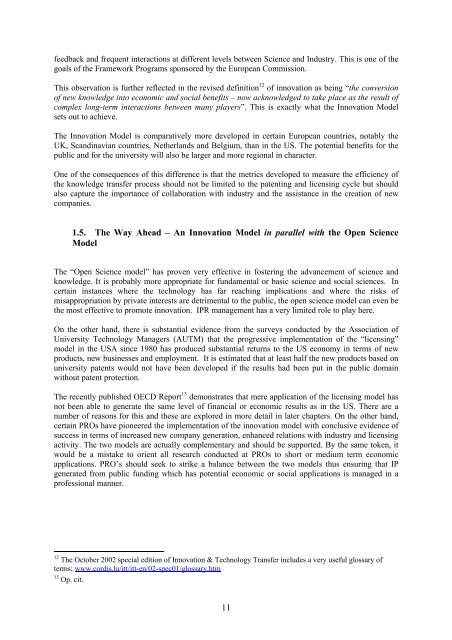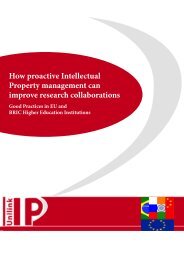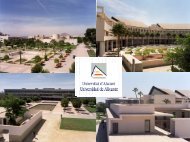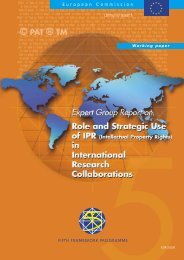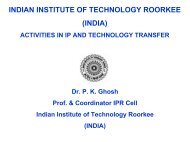Management of intellectual property in publicly-funded research
Management of intellectual property in publicly-funded research
Management of intellectual property in publicly-funded research
- No tags were found...
Create successful ePaper yourself
Turn your PDF publications into a flip-book with our unique Google optimized e-Paper software.
feedback and frequent <strong>in</strong>teractions at different levels between Science and Industry. This is one <strong>of</strong> thegoals <strong>of</strong> the Framework Programs sponsored by the European Commission.This observation is further reflected <strong>in</strong> the revised def<strong>in</strong>ition 12 <strong>of</strong> <strong>in</strong>novation as be<strong>in</strong>g “the conversion<strong>of</strong> new knowledge <strong>in</strong>to economic and social benefits – now acknowledged to take place as the result <strong>of</strong>complex long-term <strong>in</strong>teractions between many players”. This is exactly what the Innovation Modelsets out to achieve.The Innovation Model is comparatively more developed <strong>in</strong> certa<strong>in</strong> European countries, notably theUK, Scand<strong>in</strong>avian countries, Netherlands and Belgium, than <strong>in</strong> the US. The potential benefits for thepublic and for the university will also be larger and more regional <strong>in</strong> character.One <strong>of</strong> the consequences <strong>of</strong> this difference is that the metrics developed to measure the efficiency <strong>of</strong>the knowledge transfer process should not be limited to the patent<strong>in</strong>g and licens<strong>in</strong>g cycle but shouldalso capture the importance <strong>of</strong> collaboration with <strong>in</strong>dustry and the assistance <strong>in</strong> the creation <strong>of</strong> newcompanies.1.5. The Way Ahead – An Innovation Model <strong>in</strong> parallel with the Open ScienceModelThe “Open Science model” has proven very effective <strong>in</strong> foster<strong>in</strong>g the advancement <strong>of</strong> science andknowledge. It is probably more appropriate for fundamental or basic science and social sciences. Incerta<strong>in</strong> <strong>in</strong>stances where the technology has far reach<strong>in</strong>g implications and where the risks <strong>of</strong>misappropriation by private <strong>in</strong>terests are detrimental to the public, the open science model can even bethe most effective to promote <strong>in</strong>novation. IPR management has a very limited role to play here.On the other hand, there is substantial evidence from the surveys conducted by the Association <strong>of</strong>University Technology Managers (AUTM) that the progressive implementation <strong>of</strong> the “licens<strong>in</strong>g”model <strong>in</strong> the USA s<strong>in</strong>ce 1980 has produced substantial returns to the US economy <strong>in</strong> terms <strong>of</strong> newproducts, new bus<strong>in</strong>esses and employment. It is estimated that at least half the new products based onuniversity patents would not have been developed if the results had been put <strong>in</strong> the public doma<strong>in</strong>without patent protection.The recently published OECD Report 13 demonstrates that mere application <strong>of</strong> the licens<strong>in</strong>g model hasnot been able to generate the same level <strong>of</strong> f<strong>in</strong>ancial or economic results as <strong>in</strong> the US. There are anumber <strong>of</strong> reasons for this and these are explored <strong>in</strong> more detail <strong>in</strong> later chapters. On the other hand,certa<strong>in</strong> PROs have pioneered the implementation <strong>of</strong> the <strong>in</strong>novation model with conclusive evidence <strong>of</strong>success <strong>in</strong> terms <strong>of</strong> <strong>in</strong>creased new company generation, enhanced relations with <strong>in</strong>dustry and licens<strong>in</strong>gactivity. The two models are actually complementary and should be supported. By the same token, itwould be a mistake to orient all <strong>research</strong> conducted at PROs to short or medium term economicapplications. PRO’s should seek to strike a balance between the two models thus ensur<strong>in</strong>g that IPgenerated from public fund<strong>in</strong>g which has potential economic or social applications is managed <strong>in</strong> apr<strong>of</strong>essional manner.12 The October 2002 special edition <strong>of</strong> Innovation & Technology Transfer <strong>in</strong>cludes a very useful glossary <strong>of</strong>terms; www.cordis.lu/itt/itt-en/02-spec01/glossary.htm13 Op. cit.11


